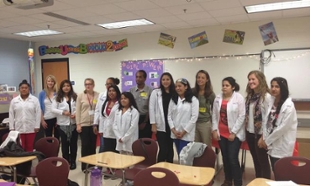Preparing for the 21st-century classroom
Education
SUMMARY: The science discipline is one of the most demanding for teachers working with English Language Learner students. Biology professor Kerry Cresawn and JMU future teachers worked on a project finding innovative ways to give all students equal access to quality science education.
JMU effort helps English Language Learners prosper in science classrooms

The future of America's classrooms
What will the classroom of the future look like?
Projections indicate that by 2040, 40 percent of the nation’s school population will be comprised of English Language Learners, ELLs — students who may struggle to communicate fluently in English.
Educators agree these students are a rich, and welcome, influence in America’s classrooms. In one survey, 78 percent of teachers said “language minority students bring needed diversity to schools.” Yet 70 percent of those educators were not interested in ELLs in their classrooms.

Why the disparity?
In many respects, English Language Learners pose a seemingly insurmountable challenge for teachers who say they lack needed training and resources to be effective in educating ELL students.
It is a problem close to JMU’s home. One third of Harrisonburg City schools’ students are English Language Learners; there are 53 languages spoken in the city’s schools.
"All students should have equal access to quality science education. I wanted to find a way to modify content-area instruction so that my students could be effective in teaching ELLs ." — Assistant Professor of Biology Kerry Cresawn
Designing culturally relevant education
Kerry Cresawn, JMU biology professor, sees urgency behind these statistics. Cresawn instructs JMU’s interdisciplinary liberal studies majors who are preparing to teach science in PreK-8 classrooms. The science discipline is one of the most demanding for teachers working with English Language Learner students. Technical vocabulary, words that have different meanings in science than in spoken English, long sentences, and passive voice are rarely friendly, even to English-speaking students, and pose real challenges for students with limited English.
“I have a passion for social justice in science education. All students should have equal access to quality science education. I wanted to find a way to modify content-area instruction so that my students could be effective in teaching ELLs and confident in their abilities to help ELLs succeed,” she says.
Working with Diane Secord, a literacy specialist at Skyline Middle School, Cresawn selected five JMU interdisciplinary liberal studies students for a project funded by JMU’s Office of Diversity. Each of the IdLS students in the project had declared science as one of their concentrations.
The IdLS students were tasked with designing and implementing investigative, level-appropriate science experiences that were culturally relevant and incorporated reading, writing and speaking for ELL learners. Ten 7th- and 8th-grade ELL students whose home countries included the Dominican Republic, Iraq, Jordan, Mexico, Puerto Rico and Russia, participated. “Most of these students were born in the U.S.,” says Secord, “but they were not making advancement in English skills.”

“The JMU students received a concentrated intensive experience working with one of the traditionally marginalized student populations in science — ELLs,” says Cresawn. Though small-scale, she says the project showed it was possible to “give ELL students confidence in their ability to do science, to think of science as a career, and to consider JMU as a place where they can study science.”
"The reason I want to teach biology is because of the experiences I’ve had in Dr. Cresawn’s course where I was able to teach science to ELLs." -- Leisha Martin (’14, ’15M)'
The preservice teachers will embark on their careers with a tool kit for cultural and literacy instruction in the science classroom. More than one JMU student praised the invaluable insight they received into strategies and techniques that could be used with ELLs as well as other students who need remedial extended attention. They expressed increased confidence in their ability to succeed.
“The reason I want to teach biology is because of the experiences I’ve had in Dr. Cresawn’s course where I was able to teach science to ELLs,” says Leisha Martin (’14, ’15M).
The role of higher education

“Higher education can have a important impact on the ELL population. JMU professors have rich backgrounds in content areas, whether it’s science, arts, social studies or math,” says Cresawn. “While we’re not trained to work with K-12 students or ELLs, thousands of future teachers are being trained in Madison’s IdLS program. Productive collaboration between content experts, future teachers and K12 in-service teachers is a way to bring much needed diversity into our respective disciplines and help narrow the achievement gap in our nation’s classrooms.”
This type of collaboration, a hallmark of JMU as the engaged university, could signal significant, positive developments for the classroom of the future.
